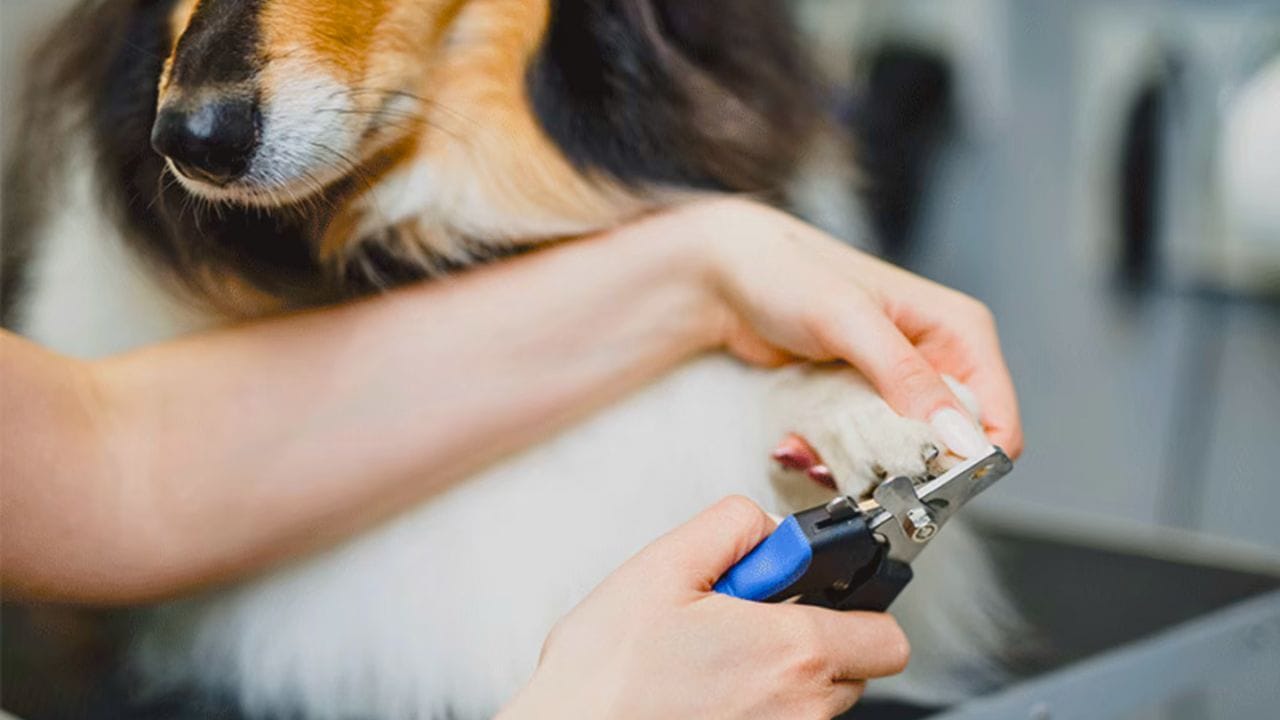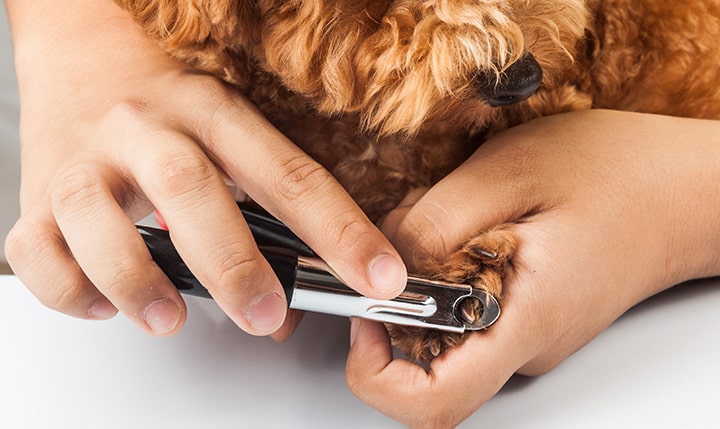Cutting a puppy's nails can be a daunting task for many new pet owners. However, it is an essential part of their grooming routine to ensure their overall health and well-being. Long nails can cause discomfort, pain, and even lead to infections in puppies. Therefore, it is crucial to learn how to cut puppy nails safely and effectively.

The first step in cutting a puppy's nails is to choose the right tools. There are several options available, including clippers, grinders, scissors, and nail files. It is important to select the tool that you are most comfortable using and that works best for your puppy's nails. Additionally, it is recommended to have styptic powder on hand in case of accidental bleeding.
Once you have chosen the right tool, it is important to get your puppy comfortable with the process. This can be achieved by handling their paws regularly and providing positive reinforcement, such as treats and praise. It is also essential to know how to locate the quick, which is the pink area of the nail that contains blood vessels and nerves. Cutting the quick can cause pain and bleeding, so it is important to avoid it. With the right tools and techniques, cutting your puppy's nails can become a stress-free part of their grooming routine.
Understanding Puppy Nail Anatomy
When it comes to cutting puppy nails, it is important to understand the anatomy of the nail. Puppies' nails, like those of adult dogs, are made of a hard protein called keratin. The nail is composed of several parts, including the nail bed, nail plate, and the quick.

Identifying the Quick
The quick is a blood vessel that runs through the center of the nail and provides blood supply to the nail. It is important to identify the quick before cutting the nail to avoid causing pain or bleeding. The quick is easily visible in light-colored nails, but it can be more difficult to see in dark-colored nails.
Nail Structure and Growth
Puppies' nails grow continuously, and they need to be trimmed regularly to prevent them from becoming too long. The nail plate is the hard outer covering of the nail, and it grows from the base of the nail bed. The nail bed is the soft tissue underneath the nail plate that provides support and nourishment to the nail.
When cutting puppy nails, it is important to trim only the tip of the nail and avoid cutting into the quick. Cutting into the quick can cause pain and bleeding and may make the puppy fearful of future nail trims. Regular trimming of the nails will help to keep them at a healthy length and prevent discomfort or injury to the puppy.
Preparing for the Nail Cutting Session
Before starting the nail cutting session, it is important to gather all the necessary tools, create a calm environment, and acclimate your puppy to nail trimming.
Gathering Necessary Tools
To ensure a successful nail cutting session, it is important to have all the necessary tools. The following tools are essential for cutting puppy nails:
- Nail clippers or a grinder
- Styptic powder or cornstarch
- Treats
- Flashlight (optional)
It is important to choose the right type of nail clipper for your puppy. Guillotine clippers are best for small breeds, while scissor clippers are better for larger breeds. A grinder can also be used for nail trimming and is a good option for puppies who are afraid of the sound of clippers.
Creating a Calm Environment
Creating a calm environment is crucial for a successful nail cutting session. It is important to choose a quiet and well-lit area to perform the nail trimming. Turn off any loud noises such as the TV or radio, as they can distract your puppy and cause them to become anxious.
Acclimating Your Puppy to Nail Trimming
It is important to acclimate your puppy to nail trimming to ensure a positive experience. Start by touching your puppy's paws regularly and rewarding them with treats. This will help your puppy get used to having their paws handled.

Once your puppy is comfortable with having their paws handled, introduce them to the nail clippers or grinder. Show them the tool and let them sniff it. Reward them with treats and praise.
In conclusion, preparing for a nail cutting session involves gathering necessary tools, creating a calm environment, and acclimating your puppy to nail trimming. By following these steps, you can ensure a successful and stress-free nail cutting experience for both you and your puppy.
Techniques for Safe Nail Trimming
Trimming a puppy's nails can be a daunting task, but it is essential for their health and comfort. Here are some techniques for safe nail trimming that will help make the process easier and less stressful for both you and your furry friend.
Holding the Paw Correctly
To hold a puppy's paw correctly, place your hand under their paw and use your thumb to gently press down on the pad. This will extend their nail, making it easier to see and clip. It is important to hold the paw firmly but gently to avoid causing discomfort or injury.
Cutting at the Right Angle
When cutting a puppy's nails, it is crucial to cut at the right angle. The nail should be cut at a 45-degree angle, avoiding the quick, which is the pink area inside the nail that contains blood vessels and nerves. Cutting the quick can be painful and cause bleeding, so it is essential to be cautious and use sharp, high-quality nail clippers.
Determining the Correct Nail Length
Determining the correct nail length can be tricky, especially for first-time puppy owners. A good rule of thumb is to trim the nail to just below the level of the paw pad. If the nail is touching the ground when the puppy is standing, it is too long and should be trimmed. It is better to trim a little at a time, rather than risk cutting the quick.

By following these techniques for safe nail trimming, you can help keep your puppy's nails healthy and comfortable. Remember to be patient and gentle, and always reward your furry friend with treats and praise for a job well done.
Dealing with Accidents
Accidents can happen even to the most experienced pet owners. If you accidentally cut your puppy's nail too short, causing bleeding, don't panic. Here's what you can do to stop the bleeding and provide comfort and care to your furry friend.
Stopping Nail Bleeding
First, apply pressure to the nail with a clean cloth or gauze. Hold it in place for a few minutes until the bleeding stops. If the bleeding persists, you can use a styptic powder or pencil to stop the bleeding. These products contain a coagulant that helps to stop bleeding quickly. Simply dip the bleeding nail into the powder or apply the pencil directly to the bleeding nail. Be sure to keep these products on hand when trimming your puppy's nails.
Providing Comfort and Care
After stopping the bleeding, it's important to provide comfort and care to your puppy. Offer your puppy a treat or a favorite toy to distract them from the discomfort. You can also soothe your puppy by holding them and petting them gently. If your puppy is in pain, you can give them a pain reliever recommended by your veterinarian.
It's important to keep an eye on the injured nail and watch for signs of infection. If the nail becomes red, swollen, or pus-filled, contact your veterinarian immediately. They may prescribe antibiotics or recommend other treatments to prevent infection.

Remember, accidents happen, and it's important to stay calm and take action to stop the bleeding and provide comfort and care to your furry friend. With these tips, you can help your puppy recover from a nail trimming accident quickly and easily.
Aftercare and Nail Maintenance
After trimming the nails of an 8-week-old puppy, it's essential to provide appropriate aftercare to ensure the puppy's paws remain healthy. The following subsections describe the best practices for aftercare and ongoing nail maintenance.
Soothing the Paws
It's common for puppies to feel a bit uneasy after nail trimming. To soothe their paws, gently massage their feet and offer them a treat. Applying a small amount of petroleum jelly or a paw balm can also help soothe their paws.
Regular Nail Check and Trim Schedule
To maintain healthy paws, it's crucial to check your puppy's nails regularly. The frequency of trimming depends on the puppy's breed, size, and activity level. A general rule of thumb is to trim your puppy's nails every two to four weeks.
It's best to use a sharp, high-quality nail clipper or grinder to avoid injury to the puppy's paw. When trimming the nails, be sure to avoid cutting the quick, which is the blood vessel that runs through the nail. If you accidentally cut the quick, apply styptic powder to stop the bleeding.
In conclusion, with the right tools and techniques, cutting your puppy's nails can be a quick and easy process. By providing appropriate aftercare and maintaining a regular nail trimming schedule, you can ensure your puppy's paws remain healthy and happy.
Professional Grooming Options
When it comes to grooming puppies, there are many options to choose from. One of the best options is to take your puppy to a professional groomer. Here are some things to consider when choosing a professional groomer:
Choosing a Professional Groomer
When choosing a professional groomer, it is important to do your research. Look for a groomer who has experience with puppies and who is knowledgeable about the breed of your puppy. You can ask for recommendations from friends, family, or your veterinarian.
It is also important to visit the groomer's facility before making an appointment. Make sure the facility is clean and well-maintained. The groomer should have all the necessary equipment and supplies to groom your puppy safely and effectively.

Understanding the Benefits of Professional Care
There are many benefits to taking your puppy to a professional groomer. Professional groomers have the experience and expertise to groom your puppy safely and effectively. They can also provide additional services such as ear cleaning, teeth brushing, and nail trimming.
Professional groomers can also help you identify any potential health issues your puppy may have. They can alert you to any lumps, bumps, or other abnormalities that may require veterinary attention.
In addition, taking your puppy to a professional groomer can help socialize them. They will learn to interact with other dogs and people in a safe and controlled environment.
Overall, taking your puppy to a professional groomer can be a great way to ensure they receive the care they need to stay healthy and happy.
Conclusion
Cutting a puppy's nails is a crucial part of their grooming routine, essential for their comfort and health. By understanding nail anatomy, using the right tools, and acclimating your puppy to the process, you can make nail trimming a stress-free experience. Techniques such as holding the paw correctly and cutting at the right angle ensure safety and effectiveness.
Accidents can happen, but knowing how to stop bleeding and provide comfort helps manage them. Regular nail maintenance and professional grooming options further support your puppy's well-being. With patience and proper care, you can keep your puppy's nails in optimal condition, promoting their overall happiness and health.




